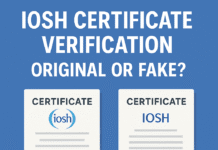
IOSH Safety Manager: 50 Duties Of A IOSH Safety Manager
Introduction to IOSH Safety Managers
In the realm of workplace safety, IOSH (Institution of Occupational Safety and Health) Safety Managers stand as sentinels, ensuring organizations uphold the highest standards of safety. These professionals, armed with IOSH certification, play a pivotal role in creating secure and healthy work environments.
Significance of IOSH Certification for Managers
Before diving into the extensive duties of an IOSH Safety Manager, it’s crucial to acknowledge the significance of IOSH certification. This certification serves as a mark of distinction, validating the manager’s proficiency in implementing and maintaining safety measures in accordance with IOSH standards.
Core Responsibilities of an IOSH Safety Manager
Ensuring Adherence to IOSH Standards
A fundamental duty of an IOSH Safety Manager is to ensure organizational adherence to IOSH standards. Staying abreast of updates in safety guidelines and conducting regular assessments ensures that the workplace aligns with the latest IOSH regulations.
Conducting In-Depth Risk Assessments
IOSH Safety Managers excel in conducting in-depth risk assessments. This involves identifying potential risks, evaluating their impact, and strategizing to mitigate or eliminate these risks. Regular risk assessments are crucial for proactive safety management.
Crafting and Implementing Safety Policies
Developing Comprehensive Safety Procedures
One of the primary responsibilities of an IOSH Safety Manager is the development of comprehensive safety policies and procedures. These documents serve as a roadmap, guiding employees on best practices, emergency protocols, and safety measures to be adhered to in the workplace.
Effectively Communicating Policies to the Workforce
Creating policies is only half the battle; effective communication is the key. IOSH Safety Managers ensure that all employees are well-informed about safety procedures through engaging training sessions, workshops, and consistent communication channels.
Emergency Preparedness and Response
Establishing and Communicating Emergency Protocols
Preparedness for unforeseen events is paramount. IOSH Safety Managers are instrumental in establishing and communicating emergency protocols. This ensures that employees are well-prepared to respond to accidents, natural disasters, or any other emergencies.
Conducting Regular Emergency Drills
To validate the effectiveness of emergency protocols, IOSH Safety Managers organize regular drills. These simulations help employees practice their response, ensuring a swift and effective reaction in real emergency situations.
Hazard Identification and Control Measures
Thorough Workplace Inspections for Hazards
IOSH Safety Managers conduct detailed workplace inspections to identify potential hazards. These inspections cover everything from machinery and equipment to environmental factors, ensuring a comprehensive assessment of safety risks.
Implementing Proactive Hazard Controls
Identifying hazards is only the first step. IOSH Safety Managers implement proactive control measures to minimize or eliminate risks. This could involve modifying processes, upgrading equipment, or providing additional protective measures.
Incident Investigation and Reporting
Analyzing Workplace Incidents
In the unfortunate event of a workplace incident, IOSH Safety Managers play a vital role in investigating the incident. They analyze the root causes, contributing factors, and the effectiveness of existing safety measures to prevent similar incidents in the future.
Documenting Incident Reports Accurately
Accurate documentation of incidents is essential for learning from past experiences. IOSH Safety Managers ensure that all workplace incidents are thoroughly documented, providing valuable data for analysis and future reference.
Training and Development Initiatives
Creating Engaging Training Modules
IOSH Safety Managers contribute to the development of engaging training modules and educational programs. These initiatives aim to enhance the safety knowledge and skills of employees at all levels within an organization.
Promoting a Culture of Continuous Learning
Continuous education is vital for maintaining a safety-conscious workplace. IOSH Safety Managers keep staff informed about safety updates, new procedures, and relevant industry developments, ensuring everyone is on the same page.
Safety Audits and Inspections
Regular Audits Ensuring IOSH Compliance
IOSH Safety Managers conduct regular safety audits to assess compliance with IOSH regulations and internal policies. These audits help identify areas that may need improvement and ensure that the workplace remains aligned with industry standards.
Swiftly Addressing Non-Compliance Issues
If any non-compliance issues are identified during audits, IOSH Safety Managers take prompt action to address them. This may involve implementing corrective measures, providing additional training, or updating existing safety protocols.
Collaboration with Stakeholders
Effective Engagement with Management
Effective collaboration with management is crucial for implementing comprehensive safety measures. IOSH Safety Managers work closely with organizational leadership to align safety initiatives with overall business goals and objectives.
Collaborating with Employees and Unions
Collaboration extends to engaging employees and unions in the safety process. IOSH Safety Managers foster a culture of safety by involving workers in safety programs, seeking their input, and addressing concerns raised by unions to create a safer and more inclusive work environment.
Environmental Health and Safety
Identifying and Mitigating Environmental Risks
Beyond workplace safety, IOSH Safety Managers assess and mitigate environmental risks. This includes identifying factors that may impact the environment and implementing measures to minimize the organization’s ecological footprint.
Encouraging Sustainable Practices
IOSH Safety Managers play a role in promoting sustainability within the workplace. They recommend and implement practices that reduce the environmental impact of the organization, aligning with global efforts for a greener and safer world.
Personal Protective Equipment (PPE)
Assessing and Recommending PPE
IOSH Safety Managers assess the specific personal protective equipment (PPE) requirements for different roles within the organization. This includes evaluating the effectiveness of existing PPE and recommending upgrades or changes as needed.
Ensuring Proper Utilization of PPE
Providing PPE is only part of the equation; ensuring its proper usage is equally important. IOSH Safety Managers educate employees on the correct use of protective gear and monitor compliance to maximize its effectiveness.
Crisis Management Strategies
Developing and Implementing Crisis Plans
IOSH Safety Managers contribute to the development of crisis management plans. These plans outline step-by-step procedures to be followed in the event of a crisis, ensuring a coordinated and effective response.
Leading Crisis Response Teams
In times of crisis, IOSH Safety Managers take on leadership roles in coordinating response efforts. This includes managing crisis response teams, liaising with relevant authorities, and ensuring a swift and organized reaction to mitigate potential damage.
Continuous Improvement and Analysis
Analyzing Safety Metrics for Enhancements
IOSH Safety Managers continuously analyze safety performance metrics. This involves reviewing incident reports, audit findings, and employee feedback to identify areas for improvement and implement proactive measures.
Implementing Feedback Mechanisms for Growth
Feedback is a valuable tool for ongoing improvement. IOSH Safety Managers establish mechanisms for collecting feedback from employees, incorporating their insights into safety initiatives and fostering a culture of continuous improvement.
An IOSH (Institution of Occupational Safety and Health) Safety Manager is responsible for overseeing and managing health and safety programs within an organization. Here are 50 duties that an IOSH Safety Manager may perform:- Develop and implement health and safety policies in accordance with IOSH standards.
- Ensure compliance with local and international health and safety regulations.
- Conduct risk assessments to identify and mitigate workplace hazards.
- Provide leadership and direction to the health and safety team.
- Conduct health and safety training and orientation for employees.
- Investigate accidents and incidents to determine root causes.
- Develop and implement emergency response plans.
- Oversee health and safety audits and inspections.
- Advise senior management on health and safety matters.
- Monitor and evaluate workplace activities for compliance with health and safety protocols.
- Analyze accident data to identify trends and areas for improvement.
- Collaborate with other departments to address health and safety concerns.
- Develop and implement a behavior-based safety program.
- Implement and manage a permit-to-work system for hazardous tasks.
- Ensure the proper use of personal protective equipment (PPE).
- Review and update health and safety documentation regularly.
- Conduct hazard communication programs.
- Oversee the use of health and safety signage and labels.
- Monitor and control exposure to hazardous substances.
- Review and approve contractor health and safety plans.
- Collaborate with healthcare professionals on employee wellness and health programs.
- Conduct health and safety drills and emergency evacuation exercises.
- Implement and manage a health and safety management system.
- Evaluate the effectiveness of health and safety measures.
- Investigate and report on near misses.
- Develop and implement health and safety incentives and recognition programs.
- Participate in health and safety committee meetings.
- Review and approve health and safety-related budgets.
- Conduct health and safety briefings for new employees.
- Monitor compliance with machine guarding requirements.
- Collaborate with environmental health professionals on workplace safety.
- Conduct noise level monitoring and implement controls.
- Assess and implement fall protection measures.
- Implement and manage a respiratory protection program.
- Monitor compliance with electrical safety standards.
- Develop and maintain Material Safety Data Sheets (MSDS).
- Conduct health and safety workshops and seminars.
- Evaluate the effectiveness of health and safety training programs.
- Collaborate with fire safety professionals for prevention planning.
- Conduct health and safety culture assessments.
- Monitor and control ergonomic risks in the workplace.
- Review and approve health and safety plans for construction projects.
- Evaluate and recommend improvements in workplace lighting.
- Monitor compliance with confined space entry requirements.
- Implement lockout/tagout procedures.
- Assess and manage workplace stress and mental health.
- Conduct health and safety inspections for machinery and equipment.
- Review and approve health and safety measures for remote and fieldwork.
- Implement and manage a process safety management program.
- Stay updated on changes in health and safety regulations and industry best practices.
These duties are indicative, and the specific responsibilities may vary based on the industry, organization, and job role of the IOSH Safety Manager.Conclusion
In conclusion, IOSH Safety Managers play a pivotal role in ensuring the safety and well-being of individuals within an organization. From crafting effective safety policies to leading emergency response efforts, these professionals contribute significantly to the overall safety culture of a workplace. With their diverse skill set and commitment to continuous improvement, IOSH Safety Managers are indispensable in today’s dynamic and evolving work environments.
How to Check IOSH Accreditation
How to Become an IOSH Approved Trainer
How to Register for IOSH Training Certification Program
IOSH Safety Manager: IOSH Certified Safety Manager Salary
IOSH Safety Engineer: IOSH Certified Safety Engineer Salary
FAQs
- What is IOSH certification, and why is it crucial for safety managers? IOSH certification, provided by the Institution of Occupational Safety and Health, validates the expertise of safety managers in implementing and maintaining safety measures. It is crucial for professionals in the field to ensure workplaces adhere to the highest safety standards.
- How often should safety audits be conducted in an organization? Safety audits should be conducted regularly, at least annually, to assess compliance with IOSH regulations and internal safety policies. Regular audits help identify areas for improvement and ensure ongoing adherence to safety standards.
- How do IOSH Safety Managers contribute to environmental sustainability in the workplace? IOSH Safety Managers assess and mitigate environmental risks, recommending and implementing practices that reduce the organization’s ecological footprint. They play a role in promoting sustainability within the workplace.
- What role do IOSH Safety Managers play in crisis management? IOSH Safety Managers play a vital role in crisis management by contributing to the development of crisis plans and leading crisis response teams. Their expertise ensures a coordinated and effective response in times of crisis.
- How can IOSH Safety Managers foster a culture of continuous improvement within an organization? IOSH Safety Managers foster a culture of continuous improvement by analyzing safety metrics, implementing feedback mechanisms, and actively involving employees in the ongoing enhancement of safety initiatives.
























